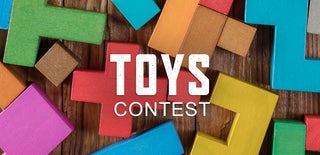Introduction: Think-a-Dot Replica
Think-a-Dot is a puzzle game invented by Joseph A. Weisbecker and sold by Education Science Research (E.S.R. Inc.) in the mid to late 60's.
Think-a-Dot has an upright frame with eight dots on the front face, in rows of three, two, and three. The dots are one of two colors, blue and yellow by convention, that indicate the state of a flip-flop gate inside the frame. There are three openings in the top of the unit through which marbles can be dropped. When a marble travelling through the game encounters a gate, it will both flip the state of the gate (changing it's color), and be deflected to the left or right depending on the initial state of the gate. Marbles drop to the bottom of the frame and are collected in side pockets to be reused.
You reset the game to one of two starting positions by tilting the frame to the right or left, so that all the gates face the same way. The four corner gates are colored differently so that they will always be the opposite color of the rest of the dots. Given a particular target pattern of dots, the goal is to drop marbles into the holes at the top until the target pattern is reached in as few moves as possible.
There are many very good online references for Think-a-Dot. Here are a few to get you started:
Also, along with the STL files for this project, you will find a PDF of the leaflet that came with the original Think-a-Dot. I brought this file to a local copy center and had them print me a few stapled booklets on glossy paper. Super happy with the results.
Think-a-Dot games are getting rarer by the day. My goal in creating this replica is to help preserve this great little game and honor the creativity of it's inventor.
Design Notes
I hesitate to call what I did design. The real design work happened back in the mid 60's. Think-a-Dot was modeled completely with Tinkercad. This is my first substantial modelling effort.
I was able to get my hands on an original Think-a-Dot as a reference. I tell people that I did the modelling with digital calipers, Tinkercad, and patience. I thoroughly enjoyed the whole process. Tinkercad is a very organic experience and it felt more like sculpting to me than 3D design.
I started with the Flip Flops. These are a natural for Tinkercad as they are basically made up of cylinders and slabs. The Display piece was done next. When I was satisfied with the result I used the Display as the starting point for the Back piece, extending the edges slightly and adding walls. Finally the Front was made from the Back by removing the holes and marble guides, adding the Display view port, and adjusting the walls while adding the wrap around trim.
Step 1: Print the Parts
Print Resolution: 0,20 mm and 0.05 mm
Infill: 100% for all pieces.
Filament: AMAZ3D and Fused Filament PLA and PETG red and white
Notes:
- The Front, Back, and Display pieces can all be printed at 0.20 mm with no supports in PLA.
- I printed the Flip Flops (8 are required) in PETG for added strength at 0.05 mm with supports.
- The optional Logo was printed at 0.05 mm in PLA.
- The Display Lines are also optional. I used a 1 mm raft at 0.05 mm in PLA.
Step 2: Post-Printing
Finishing the Flip Flops
Once the Flip Flops are printed and the support material removed, the bottom face of the half circle must be painted half blue and half yellow. Four of the pieces will be painted with blue on the left and yellow on the right. The other four will be the opposite with yellow on the left and blue on the right.
Optionally Add the Logo and Display Lines
Should you choose to make your game look more authentic, you can print and add the E.S.R. Think-a-Dot logo to the Front piece, and add the Line pattern to the Display. I used Loctite Super Glue and was happy with the results.
Step 3: Assemble Your Think-a-Dot
- Place the Front piece face down on a flat surface.
- Take the Display piece with the back facing up and slide it under the two tabs at the top of the Front piece. Slide the bottom of the Display down the single tab at the bottom of the Front piece. The Display should click into place. Slide the Display under the bottom tab as far as it will go.
- Place the 8 Flip Flops onto the Display as shown above. Make sure that all of them are oriented in the same direction, and that you have all of the blue sides (as indicated by the blue dots in the picture) oriented correctly.
- Gently slide the Back piece onto the Front using the tabs and slots. Try to keep the pieces parallel to each other and lined up. You are trying to ensure that the Flip Flops line up with the holes in the Display and Back pieces. If you are successful, when the Back and Front are fully together, should be able to tilt the frame to the left and right (while holding the Front and Back together) and all of the dots should change color as you do so.
- When you are satisfied that all of the Flip Flops are working as expected, you can carefully re set the Back applying a little glue to the edges to hold the Back and Front together. Please make sure that the Flip Flops still move freely before the glue sets!
Step 4: Have Fun
The Think-a-Dot works best with 13mm marbles. These are often found in Chinese checkers sets. Enjoy.

Participated in the
Toys Contest


















